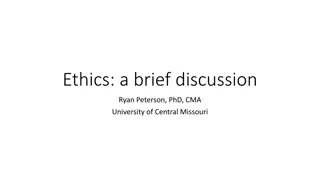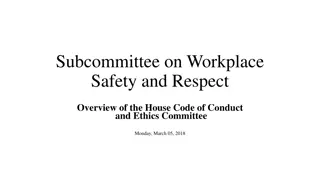
Touch Therapy and Healthy Relationships
Explore the importance of touch in therapeutic relationships and learn how to maintain healthy boundaries. Discover the impact of touch on behavior and overall health, and the significance of safe and comforting touch. Gain insights on identifying and preventing sexual misconduct in hydrotherapy sessions.
Download Presentation

Please find below an Image/Link to download the presentation.
The content on the website is provided AS IS for your information and personal use only. It may not be sold, licensed, or shared on other websites without obtaining consent from the author. If you encounter any issues during the download, it is possible that the publisher has removed the file from their server.
You are allowed to download the files provided on this website for personal or commercial use, subject to the condition that they are used lawfully. All files are the property of their respective owners.
The content on the website is provided AS IS for your information and personal use only. It may not be sold, licensed, or shared on other websites without obtaining consent from the author.
E N D
Presentation Transcript
Susan Pellandini March 2022 Hydro-Touch & Intimacy Hydrotherapy Hub
Hydro-Touch & Intimacy MODULE OBJECTIVES After completing this segment, the student will be able to: Identify that the care of touch in the therapeutic relationship is one-way and it s to be maintained by the individual giving the treatment. Contrast the reaction of soothing safe vs. upsetting touch in the therapeutic relationship. Illustrate ways of practicing healthy self-care. Describe and give examples of sexual misconduct. Describe ways to de-sexualize the hydrotherapy treatment session.
Hydro-Touch & Intimacy The two most common complaints of clients about health care professionals are: Poor communication, mostly lack of listening Violation of the practitioner: indifferent words or unwanted or insensitive touch.
Hydro-Touch & Intimacy The messages of safety and comfort we receive on our skin stick with us for the rest of our lives and have effects on our behavior. Babies that are held often are healthier and cry less. We crave healthy touch from the time we are born until the time we die. In fact, we need touch. By the time we are adults we have forgotten how to touch. Our society in the USA today is touchless and hands-free. Touch between parents and children can be confusing. Touch between lovers is strained.
Hydro-Touch & Intimacy In an effort to soothe the inherent outerskin craving, people binge-eat to soothe their inner skin and then we shame them for being overweight. Healthy touch is needful for boosting the immune system, reducing stress and being joined to community. If touch is necessary in infancy, it is vital for adulthood! In the event that one receives safe touch, a message is sent to the brain via nerve receptors in the skin and interprets whether it was soothing or insecure.
Hydro-Touch & Intimacy If it was soothing, a parasympathetic response will occur causing: Decreased heart rate Lowered blood pressure Slower breathing rate (respiration) Increased digestion If the response is upsetting, then a sympathetic response occurs causing: Increased heart rate Fear Increased blood pressure Shallow, rapid breathing The interpretation of touch is very complex and usually occurs unconsciously.
Hydro-Touch & Intimacy Researchers Heslin and Alper determined the following subconscious, analytical process: What part of my body is touched? How much pressure is used? How long does the touch last? What is the relationship between myself and the person who touched me & our situation? What verbal exchange comes with the touch? What other non-verbal behaviors are present with the touch?
Honor the Influence of Touch Due to rate of physical and sexual violence in society, individuals can view touch as a manipulative hurtful tool. Keep in mind that your subject/client is in a less powerful position and may have a difficult time saying no. This is where practitioners need to be aware of non-verbal communication. While you can learn much by listening carefully to what people say, a great deal more is revealed by what they do not say. Listen as carefully to silence as to sound. Dee Hock
Intimacy through Touch In a therapeutic relationship that involves a client s body, close association is involved which can elicit concern. Culturally, intimacy can take on different meanings with associated taboos. The appropriate intimacy in a therapeutic relationship is one-way, from practitioner to subject; never the other way around. The practitioner, is at times, touching the subject s body, usually with a towel as a barrier offering physical support. Verbal support is usually offered, with the client at times disclosing emotion thoughts and feelings. This clear boundary is surprisingly, challenging to maintain.
Intimacy through Touch For a healthy one-way therapeutic relationship to occur, self-care is essential. Practitioners that don t experience healthy intimacy elsewhere in their lives are at risk for violating the therapeutic relationship with their clients. Practicing healthy self-care includes: Knowing limitations and boundaries (emotionally, physically, sexually, verbally). Dealing with personal baggage, i.e., past abuse, trauma or neglect. Receiving healthy, safe touch outside of the treatment area. Being involved in a colleague-supervision group to process experiences. Our example and healer is Jesus who would spend nights in prayer before meeting with and healing the masses of people. He was connected with His Father and knew His identity and mission.
Hydro-Touch & Intimacy How to know if a supervisor-consultation is necessary: Does care for the subject deviate from usual protocols and professional standards? Were boundaries violated? Are you aware of strong feelings towards the subject: angry, aroused, intimidated, powerless, afraid? Did these feelings alter your behavior and treatment of the individual? Are you attracted to the client or the client attracted to you? Are you confused or conflicted regarding the therapeutic relationship?
Sexual Misconduct The problem with sexual misconduct has been around for centuries! Hippocrates addressed it in 400 BC and established the Hippocratic Oath which reads in part: Whatever house I may visit, I will come for the benefit of the sick, remaining free of all intentional injustice, of all mischief, and in particular, of sexual relationships with both female and male persons. This problem affects all professions: employers, employees, practitioners, consumers, co-workers, teachers, pastors and students. Sexual misconduct is the result of the blatant disregard of ethics, boundaries and genuine care for the client.
Sexual Misconduct There is a continuum of sexual behavior: Looking at a client in a seductive or demeaning way Making subtle comments about client s body or clothing Failure to maintain client s privacy Engaging in obvious verbal and physical flirtatious behavior Off-color jokes Strong interest or disapproval of the client s sexual orientation Conversation initiated by the practitioner about sexual problems, preferences or fantasies of the practitioner or client. Inappropriate touching and sexual behavior Unnecessary exams or treatments
Desexualizing the Treatment Experience Healthcare workers/gospel workers must be pains-taking in providing a safe environment for clients. It must be intentionally created and structured. Observe and know yourself as a practitioner. Your body language, how you dress, conversation content, thoughts outside and during the treatment, facial expressions. Know the intention of your client s visit Maintain a professional appearance and demeanor. Create a professional work space: colors, lighting, smells, sounds, d cor. Choose appropriate uplifting music. Provide informed consent. Explain the treatment and invite the client to consent. Allow privacy. YOU are responsible for a safe atmosphere, not the client.
Desexualizing the Treatment Experience Use appropriate language. Be objective about physical well-being. Always use proper draping techniques. Be observant of body contact with client. Be aware and in control. Honor boundaries at all times. Be careful with wandering eyes and mind. Keep accurate records. Participate in on-going indirect supervision with colleagues or other health professionals. Treat all clients equally. Commit to continued education.
Benjamin, Ben and Sohnen-Moe, Cherie, The Ethics of Touch, 2010 Sohnen-Moe Associates, Inc., Chapter 5 Davis, Phyllis, The Power of Touch, Hay House, Inc., 1999 Heslin and Alper, Nonverbal Communication, Sage Annual Reviews of Communications Research, Volume 11, 1982 Holy Bible, Luke 6:12 Ibid, Mark 1:35






















